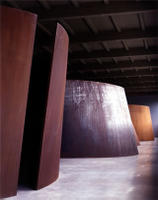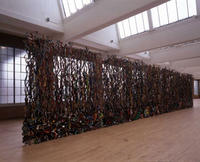Wednesday, June 29, 2005
Dia: Beacon, Two Years Later
Last weekend I paid my first visit to Dia: Beacon since shortly after it opened. I couldn’t help but notice how little has changed there in the last two years, and I was surprised by how mediocre much of what’s on display seems now that the gloss of the grand opening has worn away.
When Dia: Beacon opened in a former Nabisco box factory in May 2003, the building and the collection it housed were received with a level of media and public attention not to be topped until MoMA opened its renovated Midtown home last year. The facility drew 100,000 visitors in its first six months (against an opening year projection of 60,000) and received ample coverage in the art and mainstream press—including a cover story in the New York Times Magazine.
Two years later, the institution pushes ahead, offering a few, small special exhibitions but sticking close to its mission of presenting long-term (very long-term) installations of works by select artists.
 On the one hand, this is a blessing. The three Richard Serra torqued ellipses and one torqued spiral housed in the building’s former train shed (at right) are so wonderful that it would be a shame to ever take them off view. Ditto for the large number of works by Fred Sandback that Dia: Beacon shows. Sandback’s simple yarn pieces, the most minimal of all the minimalists’ work, never receive this much attention elsewhere.
On the one hand, this is a blessing. The three Richard Serra torqued ellipses and one torqued spiral housed in the building’s former train shed (at right) are so wonderful that it would be a shame to ever take them off view. Ditto for the large number of works by Fred Sandback that Dia: Beacon shows. Sandback’s simple yarn pieces, the most minimal of all the minimalists’ work, never receive this much attention elsewhere.
But much of the work at Dia: Beacon is second-rate work by well-known artists. Walter de Maria’s The Equal Area Series just isn’t up to the task that it’s asked to perform in the building’s long, long, light-filled opening galleries. I would much prefer to see Dia move de Maria’s The Broken Kilometer out of its Soho home and install it in these galleries. This space, with its long sight lines and beautiful light, would be the perfect location to view this much more interesting piece.
Along with de Maria, Andy Warhol gets too much space for what is pure second-rate work. His Shadows series, installed in a large gallery here for the long term, failed to impress me the first time I saw it. It failed again this time. One current special exhibition “Dia’s Andy: Through the Lens of Patronage” trots out a host of mostly mediocre works from the era when Warhol was more interested in making a buck than in making art. Seeing all these horrible, formulaic celebrity portraits from the 1980s gathered together in one place does nothing to enhance his reputation, Dia’s reputation, or the reputation of the Warhol Museum which now owns the pieces.
 Dia’s mission has always been in its commitment to a limited number of artists and its willingness to collect their work in depth. In some cases that’s a strength. Dia’s collection of Dan Flavin’s works is outstanding. So is its selection of John Chamberlain’s pieces (at right). But often this approach results in Dia holding a few remarkable works by an artist and dozens of mediocre ones. The display of Robert Ryman’s works illustrates this weakness. Two or three of his pieces on view are stellar. A number are good. The vast majority are not notable in any way.
Dia’s mission has always been in its commitment to a limited number of artists and its willingness to collect their work in depth. In some cases that’s a strength. Dia’s collection of Dan Flavin’s works is outstanding. So is its selection of John Chamberlain’s pieces (at right). But often this approach results in Dia holding a few remarkable works by an artist and dozens of mediocre ones. The display of Robert Ryman’s works illustrates this weakness. Two or three of his pieces on view are stellar. A number are good. The vast majority are not notable in any way.
To devote so much space to so much mediocre work by so many artists for such long periods of time makes me think that other opportunities are being missed. Fortunately, the high points of the collection (the Serras, the Sandback installation, the Judd pieces, the Flavin Monuments for V. Tatlin, the special exhibition of Agnes Martin paintings from the 1960s, and Michael Heizer’s Negative Megalith which takes my breath away each time I see it) more than offset that limited sense of disappointment.
When Dia: Beacon opened in a former Nabisco box factory in May 2003, the building and the collection it housed were received with a level of media and public attention not to be topped until MoMA opened its renovated Midtown home last year. The facility drew 100,000 visitors in its first six months (against an opening year projection of 60,000) and received ample coverage in the art and mainstream press—including a cover story in the New York Times Magazine.
Two years later, the institution pushes ahead, offering a few, small special exhibitions but sticking close to its mission of presenting long-term (very long-term) installations of works by select artists.
 On the one hand, this is a blessing. The three Richard Serra torqued ellipses and one torqued spiral housed in the building’s former train shed (at right) are so wonderful that it would be a shame to ever take them off view. Ditto for the large number of works by Fred Sandback that Dia: Beacon shows. Sandback’s simple yarn pieces, the most minimal of all the minimalists’ work, never receive this much attention elsewhere.
On the one hand, this is a blessing. The three Richard Serra torqued ellipses and one torqued spiral housed in the building’s former train shed (at right) are so wonderful that it would be a shame to ever take them off view. Ditto for the large number of works by Fred Sandback that Dia: Beacon shows. Sandback’s simple yarn pieces, the most minimal of all the minimalists’ work, never receive this much attention elsewhere.But much of the work at Dia: Beacon is second-rate work by well-known artists. Walter de Maria’s The Equal Area Series just isn’t up to the task that it’s asked to perform in the building’s long, long, light-filled opening galleries. I would much prefer to see Dia move de Maria’s The Broken Kilometer out of its Soho home and install it in these galleries. This space, with its long sight lines and beautiful light, would be the perfect location to view this much more interesting piece.
Along with de Maria, Andy Warhol gets too much space for what is pure second-rate work. His Shadows series, installed in a large gallery here for the long term, failed to impress me the first time I saw it. It failed again this time. One current special exhibition “Dia’s Andy: Through the Lens of Patronage” trots out a host of mostly mediocre works from the era when Warhol was more interested in making a buck than in making art. Seeing all these horrible, formulaic celebrity portraits from the 1980s gathered together in one place does nothing to enhance his reputation, Dia’s reputation, or the reputation of the Warhol Museum which now owns the pieces.
 Dia’s mission has always been in its commitment to a limited number of artists and its willingness to collect their work in depth. In some cases that’s a strength. Dia’s collection of Dan Flavin’s works is outstanding. So is its selection of John Chamberlain’s pieces (at right). But often this approach results in Dia holding a few remarkable works by an artist and dozens of mediocre ones. The display of Robert Ryman’s works illustrates this weakness. Two or three of his pieces on view are stellar. A number are good. The vast majority are not notable in any way.
Dia’s mission has always been in its commitment to a limited number of artists and its willingness to collect their work in depth. In some cases that’s a strength. Dia’s collection of Dan Flavin’s works is outstanding. So is its selection of John Chamberlain’s pieces (at right). But often this approach results in Dia holding a few remarkable works by an artist and dozens of mediocre ones. The display of Robert Ryman’s works illustrates this weakness. Two or three of his pieces on view are stellar. A number are good. The vast majority are not notable in any way.To devote so much space to so much mediocre work by so many artists for such long periods of time makes me think that other opportunities are being missed. Fortunately, the high points of the collection (the Serras, the Sandback installation, the Judd pieces, the Flavin Monuments for V. Tatlin, the special exhibition of Agnes Martin paintings from the 1960s, and Michael Heizer’s Negative Megalith which takes my breath away each time I see it) more than offset that limited sense of disappointment.